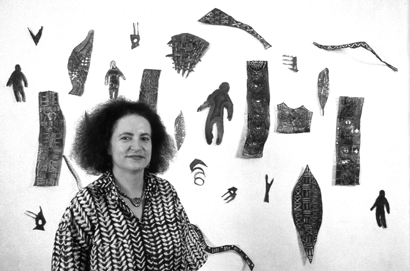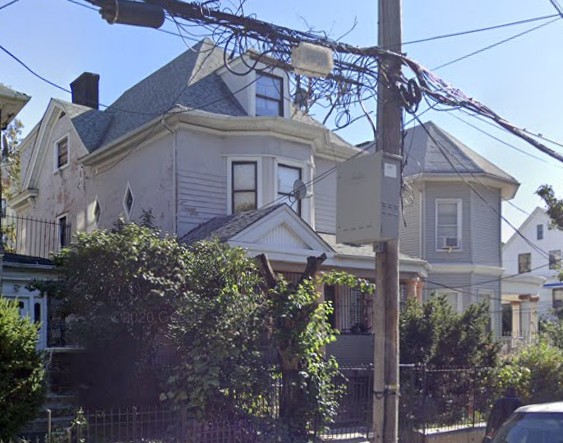By Steven Snyder
It starts as a 32-square-foot hunk of steel — a massive, inanimate black mass — and ends up as an artwork designed to cut across borders both political and psychological and to build bridges between cultures.
Call it welding with a sense of wonder.
For some 30 years, Tribeca’s Janet Goldner has been using steel as her tool of inspiration, wielding a gas torch, her experiences in Africa, specifically Mali, and her political beliefs to create unique metal sculptures that have engaged viewers worldwide in a discussion of community.
She prides herself on welding holes in the steel, which “engage the space in a different way than most sculptures do,” cutting out both larger gaps that help the piece to breathe, and thin lines that stretch, zig-zag and loop through the blackness. In Goldner’s work, solid becomes fluid; metal comes to life.
After cutting into the steel’s surface, she then adds elements to the newly-created canvas. Sometimes it’s a dark silhouette, other times a line of text or even an outline of a continent. The result, says Goldner, 54, is the culmination of a lengthy collaboration, a process of give and take with the material that she describes as a two-way conversation.
“I really love welding,” she says in her Downtown studio on Warren Street, standing among several recent works while discussing both her sculpture currently on display at the Center For Book Arts, as well as an installation recently selected for the American embassy in Mali. “In that moment, the only thing in the world is the steel and that little flame.
“It’s really a dialogue with the material. What I do is both concept-driven, as I start with an idea, but also form-driven, depending on what the material does.”
Surveying Goldner’s works, that form typically takes the appearance of a black surface broken up by fine lines, or of an open canvases sprinkled with thin black figuring. Its concept is often based on the notion that our individual differences pale in comparison to our similarities as a species and a planet. In other words, that we, as a world community, are all connected.
She points to a work titled “We Are All Immigrants,” five black, eight-foot-tall structures that in 1997 were positioned around Sara Delano Roosevelt Park on the Lower East Side. Designed to call attention to the immigration debate ripping through the political landscape, each of the bulky installations include text from George Washington and others, acknowledging that we all came to this country from somewhere else.
Goldner then recalls a pair of works she made around the time of Sept. 11. The first, created in Lithuania, was made as a multi-square “book,” in which several steel frames were connected together — like the pages of an unfolded book — each containing a different image pertaining to the history of the region.
Goldner says that Eastern Europe’s history is tainted with memories of World War II and the Nazis, and she included a line of text in the piece that urged viewers to move forward: “Can we heal from the wound of our tortured past?”
She had originally intended to replicate that work in America, but suddenly found that the text had less impact here than it did abroad. As she experimented with alternate passages, the attacks of Sept. 11 occurred and she then drafted a new message that was inscribed in a second slab of steel.
Positioned next to squares filled with interconnecting silhouettes is the sentence: “Can we acknowledge the pain we’ve caused in the world even as we struggle with our own?”
Goldner says much of her work has followed this theme of an interconnected world.
“It’s about building bridges,” she says. “It’s all about breaking down notions of ‘us’ and ‘them,’ or the questions of ‘what do they do’ versus ‘what do we do.’ Because we’re really not all that different. It’s all about seeing the commonality of us on Earth, not seeing others as evil or stupid.
“I go in asking, ‘Why?’ I know I’m the stupid one, that I’m trying to understand and appreciate something I don’t know about.”
This philosophy guided Goldner in developing “Negelan,” an installation which was recently purchased for the United States’ embassy in Mali, West Africa — a country Goldner has studied extensively, and continues to visit five to six months out of every year. Its title is a derivative of the word “Bogolan,” which is the name of a stylized type of Mali cloth. Goldner says the piece started as a random collection of small black steel shapes and figures, that had been discarded from other projects. But the more pieces she added to the project — it now exists with more than two dozen smaller shapes, all featuring inscribed designs — the more she realized how it built a bridge between her modern approach to sculpture, and the traditions behind Bogolan design.
And she says it’s a perfect piece for an American Mali embassy — a place where one country’s culture meets another.
“It reflects my status as both an insider and an outsider,” she says of “Negelan,” which fuses together the modern with the traditional, the abstract with the iconic. “It’s such a wonderful acknowledgment.”
WWW Downtown Express

























